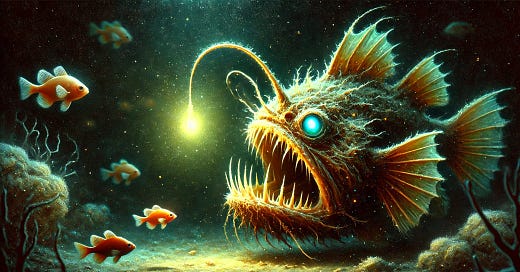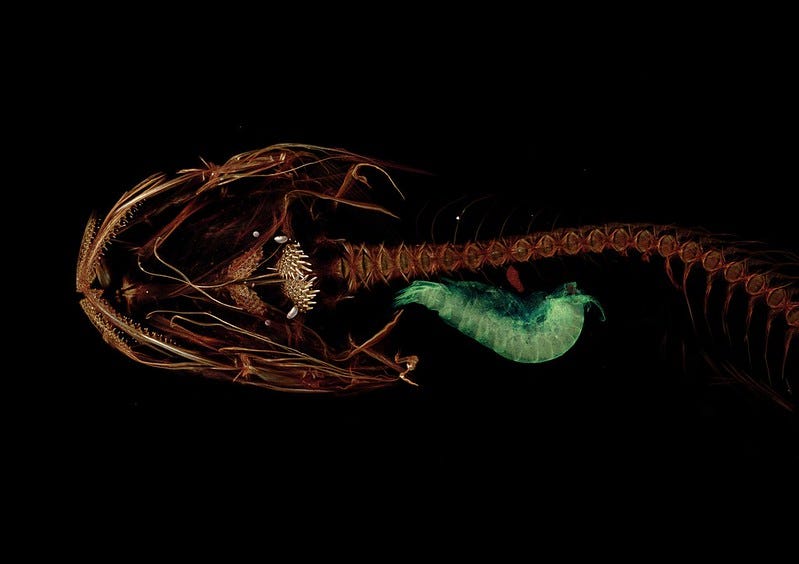Have you ever gone swimming in a place where you can go pretty deep, and tried to go down as far as you could? Some pools go down as much as 4 or 5 meters, or about 15 feet.
If you swim down there, you begin to notice a building pressure inside your ear and sinus area. The lower in that pool you go, the more this pressure builds. That’s why divers will sometimes pinch their nose and blow out slowly, equalizing the inside of the sinus cavity.
That’s because you’re underneath more water, and gravity pulls all that water down on top of you. You can feel this start to become oppressive at about ten feet, at least in my experience, and it quickly deters you from wanting to go much further. You can’t exactly do this sinus-pressure trick for your lungs, but you can put compressed air in there, which allows us to dive as far down as 40 meters, or around 130 feet.
Our oceans go down a lot further than 130 feet. The average is about 12,000 feet, or 3,682 meters. The reason you start feeling uncomfortable at the bottom of that pool is because the atmospheric pressure (the crushing pressure from all around you) is about 1.5 times what you experience on the surface.
As you continue down in the ocean, sunlight begins to fade. 200 meters down, and only 1% of the sunlight even reaches this far down. This is where the conceptual deep sea begins in the minds of many biologists and ecologists, atmospheric pressure down here is an astonishing twenty to a hundred times the pressure we deal with up on the surface. This is appropriately called the twilight zone.
Weird stuff lives in this zone (weird by human standards, anyway)—gelatinous creatures designed to use less energy and to become more buoyant, many of these animals can’t be brought to the surface or they’ll collapse. They are wired for this high-pressure environment.
Beneath this, there’s the midnight zone, where the pressure goes up from 100 times what we feel. And then, underneath this is the abyssal zone, which is where most of the ocean’s floor resides.
The abyss sees pressures around five or six hundred times what we face up on the surface, and virtually no sunlight makes it down here.
Down here, it’s incredibly dark, very cold (close to freezing), and a thousand times the atmospheric pressure we deal with on a daily basis. Just to put that into perspective, not only would an aluminum can instantly be crushed if it were somehow magically transported down here, but so would an SUV.
In fact, so would a submarine, except for a very few, very recent exceptions.
Anything that lives down here would have to have specialized body structures to withstand this crushing force. Without photosynthesis, there just aren’t any plants in the abyss. However, that doesn’t mean that there’s no light.
Some animals will use bioluminescence to light up little lures, so they can attract food. The anglerfish is one such fish.
Others might light up to communicate, or to reproduce, or to scare away prey.
Then, there’s the humble snailfish. They’re all over the deep sea, including at the bottom of the Mariana Trench, inside the Challenger Deep—the deepest spot ever recorded on earth. Here’s a nifty CT scan of one of these magnificent beauties:
Only a handful of robotic vehicles have dared to explore the Challenger Deep, but the humble snailfish is down there, living its best 1100-atmosphere life.
Food is really scarce down at the bottom, so diners can’t bee too picky. One of the main things they eat, then, is very cheekily called marine snow. While this includes lots of dead things falling to the depths, it also includes (you guessed it) tons of poop.
I love the idea that dookie is showering down on living things that are like alien life forms to us, and I love that there’s such a variety of life all over the planet. This hardly scratches the surface of what’s down below, but one way to put it into perspective is with biomass.
If you add up the weight of all the animals on Earth, you discover that about 78% of this mass is in our oceans. Most of this is in the sunlight zone, but life finds a way all the way down, as Jeff Goldblum reminds us.
What’s the most surprising form of life you know of? There are extremophiles like the tardigrade, which can survive in outer space, and there’s a sort of fungus internet out there. Land, water, and air offer amazing substrates for the incredible variety of life, but what have you been most surprised by?
What animal or other life form really made you raise your eyebrow? Let’s think today.







My deepest freedive (just me and a mask/fins) was 103ft. My lungs went from fully inflated to smaller than both my fists together or about the same size as my heart (the heart doesn't compress because of blood)
Platypus is my vote. It’s got everything, including venom. I think platypus is Latin for “pick a lane.” It has mammal, avian, and reptilian parts. It was thought to be fictional until somebody caught one.